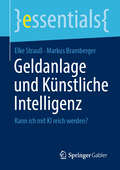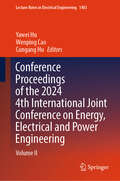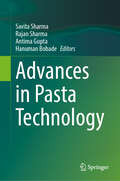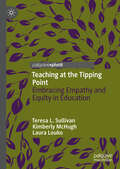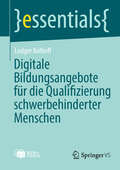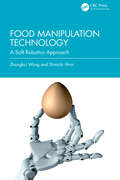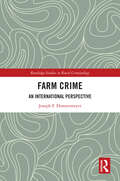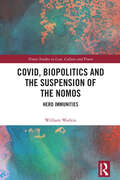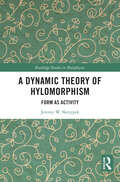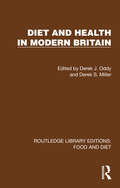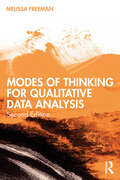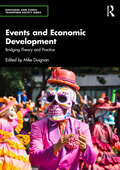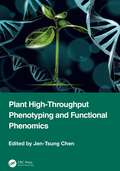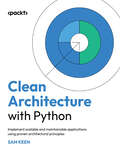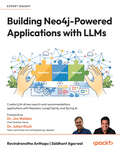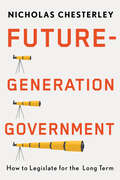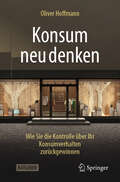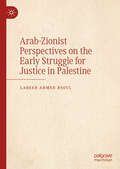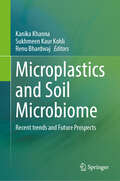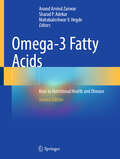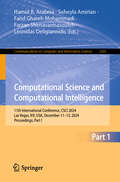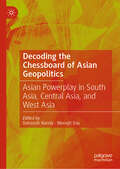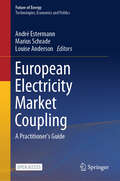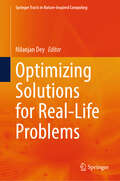- Table View
- List View
Geldanlage und Künstliche Intelligenz: Kann ich mit KI reich werden? (essentials)
by Markus Bramberger Elke StraußIn diesem essential beantworten wir die Frage, inwieweit KI Chatbot Tools wie ChatGPT bei der Wahl der richtigen Geldanlage-Strategie profitalbel sein können. Wir gehen auf effektives Prompting ein und darauf, warum die kritische Auseinandersetzung mit den Ergebnissen essenziell ist. Ein weiteres Kapitel untersucht den automatisierten Vermögensaufbau des unbedarften Anlegers mithilfe des KI Robo Advisors und erläutert, was es dabei zu beachten gilt.Schließlich widmen wir uns der Möglichkeit, direkt in vielversprechende KI-Aktien oder -ETFs zu investieren und welche Risiken man miteinbeziehen sollte.
Conference Proceedings of the 2024 4th International Joint Conference on Energy, Electrical and Power Engineering: Volume II (Lecture Notes in Electrical Engineering #1403)
by Cungang Hu Wenping Cao Yawei HuEnergy, Electrical, and Power Engineering are dynamic fields undergoing rapid change and innovation. This volume encompasses cutting-edge research and advances in electrical and power engineering, covering a wide range of topics including power electronics technology, renewable energy generation, intelligent control systems, and more. With contributions from renowned experts and scholars, it provides valuable insights and innovative solutions to address the challenges and opportunities in the ever-evolving energy landscape. This volume serves as a comprehensive resource for staying abreast of the latest trends and act as a catalyst for advancing this dynamic field. Following the success of the CoEEPE 2021, 2022 and 2023, this volume will provide resources for a diverse readership, including professionals, scientists, practitioners, researchers, and graduate students.
Advances in Pasta Technology
by Rajan Sharma Savita Sharma Antima Gupta Hanuman BobadePasta is a conventional Italian product made from durum wheat semolina and characterized by high protein content, firm shape and texture. Extrusion technology allows incorporation of a variety of ingredients to pasta such as legumes, millets, pseudo cereals and others including mushrooms, tubers and pigmented components to enrich conventional pasta. It is a convenient, popular and versatile product, offering the food industry and researchers the opportunity to offer high nutritional quality by using alternative ingredients of nutritive excellence with a high concentration of bioactive components which induce several health benefits through antioxidative pathways. To deal with compromised functional properties of resultant pasta, different techno-functional interventions including use of hydrocolloids and modification of flours which are used to improve rheological and textural profile are necessary.Advances in Pasta Technology documents the history of pasta and its rise from niche to mainstream. The book is divided into 4 sections including an introduction that covers pasta history, global market statistics, traditional pasta making technology and processing along with quality characteristics. Another section is dedicated to nutritive valorization of pasta including modulation in the bio-functional characteristics as a function of ingredients including development of gluten free pasta, micronutrient fortification approach and use of protein, fibre and antioxidant rich flours as potential alternative ingredients. Further sections focus on technological approaches to enhance the performance of specialty pasta including additives, modification of flours and processing techniques and quality management, plant project profile and cost analysis details. This text highlights every aspect of pasta science, technology and market control.
Teaching at the Tipping Point: Embracing Empathy and Equity in Education
by Teresa L. Sullivan Kimberly McHugh Laura LoukoThis book chronicles the challenges, truths, and lessons of teaching and leading in a traditional high school today: the bureaucratic red tape, the fight for inclusivity, the mental health and safety concerns, and the urgent need for teacher support and wellness. From active shooter drills to digital distractions, from closing achievement gaps to preserving educator autonomy, the challenges are immense—but so are the opportunities for change. With an honest and insightful perspective, the authors share their compelling narrative account from their extensive experiences in the trenches as both a cautionary tale and a call to action—challenging educators, policymakers, and communities to rethink how schools can truly serve students and those who teach them.
Digitale Bildungsangebote für die Qualifizierung schwerbehinderter Menschen (essentials)
by Ludger KolhoffDigitale Bildung für schwerbehinderte Menschen bietet neue Chancen zur Erweiterung beruflicher Qualifikationen und zur Stärkung der Teilhabe am Arbeitsmarkt. Doch wie lassen sich digitale Bildungsangebote in Einrichtungen der Behindertenhilfe erfolgreich umsetzen? Welche Herausforderungen gibt es, und welche Lösungen ermöglichen eine gleichberechtigte Nutzung?Dieses Buch stellt praxisnahe Konzepte, wissenschaftliche Erkenntnisse und konkrete Handlungsempfehlungen vor, die auf einem Modellprojekt basieren. Dabei werden die Perspektiven von Behindertenhilfe, Arbeitgebern und Betroffenen berücksichtigt. Zusätzlich erhalten Leser*innen Zugang zu einem ergänzenden Online-Kurs.
Food Manipulation Technology: A Soft Robotics Approach
by Shinichi Hirai Zhongkui WangWang and Hirai draw on their extensive experience to introduce recent technological advances in soft robotics for food manipulation and discuss their practical applications in the food preparation industry. They also describe food modeling and categorization for the purpose of robotic handling.Food manipulation is common in restaurants, kitchens, and food factories, but it currently largely relies on humans because of the lack of effective robotic systems. This book therefore explains recent manipulation technology for food handling and restaurant/kitchen automation, which is essential for food manipulation. The book covers the theoretical background of soft robotic hands; their application to different handling purposes in the food industry; their use in kitchen and restaurant automation; and their use for food recognition, property measuring, and modeling. The authors also present case studies of the development of soft robotic hands to illustrate the information and provide practical information that will be instructional for readers. Readers will gain an in-depth appreciation of the technology and its practical application to industry, which will enable them to implement this in their own work.This book is an essential read for both food technology practitioners and graduate students who are interested in food manipulation and its related technologies. It gives readers the theoretical background knowledge and practical understanding to apply this cutting-edge technology in real-world settings.
Farm Crime: An International Perspective (Routledge Studies in Rural Criminology)
by Joseph F. DonnermeyerA little known and under-appreciated area in criminology is knowledge about the extent, pattern, and costs of crime committed against agriculture. Farm Crime: An International Perspective is the first book to summarize the existing literature from across the globe about agricultural victimization. It demonstrates the vulnerability of farms and farm families to both property and violent crime and how it threatens their livelihood and lifestyles.Written by a pioneer of rural criminology, this book provides both a descriptive synthesis of agricultural victimization and a discussion of various criminological theories applied to its study. Despite the great diversity of farms in different regions of the world and the significant differences between the kinds of crime committed against farms from continent to continent, Farm Crime summarizes common areas of vulnerability. It provides a significant agenda for the future study of agricultural victimization, both in terms of its importance to issues of food security and the safety of farm families around the world.This book is essential reading for green criminologists, rural criminologists, mainstream criminologists, and sociologists alike. It will also be of interest to researchers and policymakers focused on issues of rural development, agricultural policy, and food security.
Covid, Biopolitics and the Suspension of the Nomos: Herd Immunities (Nomos Studies in Law, Culture and Power)
by William WatkinThis book considers how, during the unprecedented global lockdown due to the Covid-19 pandemic, the normal order of everyday life, of the rule of law, of power itself was interrupted, and hence the nomos of this earth was suspended.Employing the term ‘herd immunity’ from vaccination science and global lockdown policy as a guiding theme, the book considers two central aspects of the pandemic. These are the function of herding and collecting as a definition of ontology after Alain Badiou, and the concept of immunity as a suspension of oppositional differences in the work of Roberto Esposito. It then considers how herd immunity not only disrupts the nomos but also suspends its significance as a guiding principle of state-sanctioned legal norms—and perhaps permanently. Providing critical readings of masking, social distancing, compliance, vulnerability, bubbles, immunity, breathing, anti-vaxxers, nudge theory, cocooning, lockdown, patient zero, and the many other terms that became commonplace between 2020 and 2022, the book traces a suspension of legal and social norms, a manipulation of our compliance using false science, and a reconfiguring of the social nomos, in light of the threats of the virus. In a highly original mix of contemporary and post-war continental philosophy, biopolitical theory, set theoretical mathematics, extensional logic, and the most up-to-date science in the area, it argues that lockdown was not some global, biopolitical power grab, but actually a weakening of power, of nomos.This book will appeal to scholars and others in a range of disciplinary areas with interests in the legacy of Covid; but especially those working in the areas of continental philosophy, contemporary legal theory, and biopolitics.
A Dynamic Theory of Hylomorphism: Form as Activity (Routledge Studies in Metaphysics)
by Jeremy W. SkrzypekThis book introduces a novel hylomorphic theory of material objects, according to which material objects are understood as comprised or composed of both matter and activity, where activity plays the role of form. This theory, “hyloenergeism,” captures the dynamic nature of many of the objects of our experience, such as living organisms, better than other leading varieties of contemporary hylomorphism.Hylomorphism is the theory according to which material objects are understood as comprised or composed of two fundamental parts, components, aspects, or principles: matter and form. Many contemporary hylomorphists endorse a version according to which the form of a material object is understood as a certain kind of complex relation or structure realized in its material parts. Others endorse a version according to which the form of a material object is understood as a certain kind of power or disposition continuously activated in the object or in its material parts. This book argues against structural and dispositional varieties of hylomorphism in favor of a third approach: hyloenergeism. Drawing on various aspects of traditional Aristotelian hylomorphism and other contemporary occurrence-based theories of material objects, it argues that hyloenergeism has the resources to successfully avoid or resolve several major concerns for other competing hylomorphic views.A Dynamic Theory of Hylomorphism will appeal to researchers and graduate students working in metaphysics, ancient philosophy, and medieval philosophy.
Diet and Health in Modern Britain (Routledge Library Editions: Food and Diet)
by Derek J. Oddy Derek S. MillerOriginally published in 1985, Diet and Health in Modern Britain examines the changes in diet and health in Britain during the rapid social development of the late nineteenth and early twentieth centuries. It is particularly concerned with the ways in which the problems of urban life were ameliorated. How was infant and child mortality reduced? How did family life go on in conditions where income was low and sometimes intermittent, where protected water supplies and proper sanitation were not available, and where food preservation and food technology were still limited? How did the state devise diets for those in its care? What were the choices available for consumers?The contributors to this book were historians and nutritionists and this gives a strong interdisciplinary flavour to the volume. Many of the problems encountered during British urban development were being experienced in the developing world at the time. The way in which Britain coped with the health hazards of late-nineteenth-century urban squalor had much to tell those concerned with similar problems in contemporary cities in the developing world. The book makes clear that life in Britain in the late-nineteenth and early-twentieth centuries and life in the developing world at the time represented similar stages of the process of demographic transition.
The Politics of Food (Routledge Library Editions: Food and Diet)
by George DarlingOriginally published in 1941, a popular discussion on Food Policy was very welcome at a time when it had become a personal problem for every housewife. It was the purpose of this book to bring home to the general public the nature of the problem. The author first exposes capitalism’s failure to feed the people adequately either in peace or war. He traces the failure to its root cause, and points out that this nation had never had a food policy. Finally, he shows how policy could be re-cast on a cooperative basis to meet the conditions resulting from the war. Today it can be read in its historical context.This book is a re-issue originally published in 1941. The language used is a reflection of its era and no offence is meant by the Publishers to any reader by this re-publication.
Modes of Thinking for Qualitative Data Analysis
by Melissa FreemanModes of Thinking for Qualitative Data Analysis offers a creative and comparative account of the conceptual and philosophical underpinnings of six prominent analytical movements used by interdisciplinary qualitative researchers: Categorical thinking, narrative thinking, dialectical thinking, poetic thinking, diffractive thinking, and decolonial thinking.Each “mode of thinking” engages in a particular process for analytical sense-making. Every chapter describes core characteristics of the focal analytical movement along with examples to illustrate what that approach might look like in practice. By presenting these analytical movements in the space of a single text, the author not only highlights their unique contributions to qualitative analysis but also creates a structure from which to understand their strengths and challenges, as well as the kind of outcomes and realities each participates in shaping.This book is a thought-provoking resource for experienced and novice interdisciplinary qualitative researchers seeking to deepen their understanding of the variety of ways qualitative analysis is, and could be, theorized and practiced.
Events and Economic Development: Bridging Theory and Practice (Routledge How Events Transform Society series)
by Mike DuignanEvents and Economic Development explores the economic impact and developmental implications of designing, planning, and delivering major events – from cultural events like the Notting Hill Carnival and Day of the Dead, to sporting events like the Olympics to the Super Bowl.This book comprises 24 chapters, each addressing various diverse and interconnected topics related to the economic and development implications of hosting events. Each chapter follows a consistent structure, beginning with the aim and learning objective(s), followed by theoretical focuses and the significance of these perspectives. Similarly, practical focuses and their significance are also outlined. The main body of each chapter consists of an 800 to 2000-word argument. Following the argument, chapters include managerial, policy, and/or research implications, explicitly mapping how they relate to the UN Sustainable Development Goals. Each chapter concludes with a series of quizzes to test knowledge and debate questions to engage learners in discussing and interrogating the argument.Some of the topics covered include: Nation Branding through Events Urban Transformation via Events Commercialization of Culture and Events Crisis and Resilience in Event Management Sustainability in Event Hosting Cultural Identity and Heritage Preservation Globalization of Sports and Festivals Media and Narrative Evolution Ethics and Sponsorship in Events Community Impacts and Gentrification This innovative, topical, engaging, and comprehensive book is an essential reading and teaching resource for all students and lecturers in events that are easy to integrate into educational programmes.
Plant High-Throughput Phenotyping and Functional Phenomics
by Jen-Tsung ChenThis book provides a series of comprehensive summaries highlighting the emerging achievements in the fields of plant high‑throughput phenotyping that leads to constructing functional phenomics, one of the essential components of plant functional genomics. It presents broad aspects of methods, applications, and future directions. It offers an efficient way for readers to overview this crucial topic to realize the concept as a whole, to advance the design of their future experiments, and to inspire the exploration of the knowledge, which eventually leads to better crop development in the future by scientists, plant biologists, and crop breeders. It covers advanced tools for studying functional phenomics, including artificial intelligence, imaging, remote sensing, robotics, and aerial vehicle technologies, to empower crop speed breeding, particularly in the development of stress‑tolerant future crops. The knowledge of this book supports the Sustainable Development Goals (SDGs) of the United Nations to develop climate‑smart and sustainable agriculture for achieving zero hunger globally.
Clean Architecture with Python: Implement scalable and maintainable applications using proven architectural principles
by Sam KeenFuture-proof your Python projects by creating flexible code that adapts to changing requirements with the help of this hands-on guide to achieving clean architectureKey FeaturesLearn clean architecture through a series of real-world, code-centric examples and exercisesOptimize system componentization, significantly reducing maintenance burden and overall complexityApply clean architecture concepts confidently to new Python projects and legacy code refactoringPurchase of the print or Kindle book includes a free PDF eBookBook DescriptionIn the rapidly evolving tech industry, software applications struggle to keep pace with changing business needs, leaving developers grappling with complex codebases that resist change, ultimately reducing productivity and increasing technical debt. Clean Architecture with Python offers a powerful approach to address these challenges. Drawing from his extensive experience architecting cloud-native systems, Sam Keen helps you transform complex architectural challenges into digestible, implementable solutions. This book teaches essential principles for effective development, emphasizing the Pythonic implementation of clean architecture. Through practical examples, you'll learn how to create modular, loosely coupled systems that are easy to understand, modify, and extend. The book covers key concepts such as the dependency rule, separation of concerns, and domain modeling, all tailored for Python development. By the end of this book, you'll be able to apply clean architecture principles effectively in your Python projects. Whether you're building new systems or managing existing ones, you'll have the skills to create more maintainable and adaptable applications. This approach will enhance your ability to respond to changing requirements, setting you up for long-term success in your development career.What you will learnApply clean architecture principles idiomatically in PythonImplement domain-driven design to isolate core business logicApply SOLID principles in a Pythonic context to improve code qualityStructure projects for maintainability and ease of modificationDevelop testing techniques for cleanly architected Python applicationsRefactor legacy Python code to adhere to clean architecture principlesDesign scalable APIs and web applications using clean architectureWho this book is forIf you're a Python developer struggling with maintaining and extending complex codebases, this book is for you. It's ideal for intermediate developers looking to enhance their architectural skills as well as senior developers seeking to formalize their knowledge of clean architecture in Python. While beginners can benefit, prior experience with Python and object-oriented programming is recommended.
Building Neo4j-Powered Applications with LLMs: Create LLM-driven search and recommendations applications with Haystack, LangChain4j, and Spring AI
by Ravindranatha Anthapu Siddhant AgarwalA comprehensive guide to building cutting-edge generative AI applications using Neo4j's knowledge graphs and vector search capabilitiesKey FeaturesDesign vector search and recommendation systems with LLMs using Neo4j GenAI, Haystack, Spring AI, and LangChain4jApply best practices for graph exploration, modeling, reasoning, and performance optimizationBuild and consume Neo4j knowledge graphs and deploy your GenAI apps to Google CloudPurchase of the print or Kindle book includes a free PDF eBookBook DescriptionEmbark on an expert-led journey into building LLM-powered applications using Retrieval-Augmented Generation (RAG) and Neo4j knowledge graphs. Written by Ravindranatha Anthapu, Principal Consultant at Neo4j, and Siddhant Agrawal, a Google Developer Expert in GenAI, this comprehensive guide is your starting point for exploring alternatives to LangChain, covering frameworks such as Haystack, Spring AI, and LangChain4j. As LLMs (large language models) reshape how businesses interact with customers, this book helps you develop intelligent applications using RAG architecture and knowledge graphs, with a strong focus on overcoming one of AI’s most persistent challenges—mitigating hallucinations. You'll learn how to model and construct Neo4j knowledge graphs with Cypher to enhance the accuracy and relevance of LLM responses. Through real-world use cases like vector-powered search and personalized recommendations, the authors help you build hands-on experience with Neo4j GenAI integrations across Haystack and Spring AI. With access to a companion GitHub repository, you’ll work through code-heavy examples to confidently build and deploy GenAI apps on Google Cloud. By the end of this book, you’ll have the skills to ground LLMs with RAG and Neo4j, optimize graph performance, and strategically select the right cloud platform for your GenAI applications.What you will learnDesign, populate, and integrate a Neo4j knowledge graph with RAGModel data for knowledge graphsIntegrate AI-powered search to enhance knowledge explorationMaintain and monitor your AI search application with HaystackUse LangChain4j and Spring AI for recommendations and personalizationSeamlessly deploy your applications to Google Cloud PlatformWho this book is forThis LLM book is for database developers and data scientists who want to leverage knowledge graphs with Neo4j and its vector search capabilities to build intelligent search and recommendation systems. Working knowledge of Python and Java is essential to follow along. Familiarity with Neo4j, the Cypher query language, and fundamental concepts of databases will come in handy.
Future-Generation Government: How to Legislate for the Long Term
by Nicholas ChesterleyIn the decades preceding COVID-19 there were nine pandemics or near-pandemics, from SARS to Ebola. Despite this turbulent recent history, many governments were unprepared for the recent pandemic and remain ill-equipped for the next.Our impact on future generations has never been greater, and the challenges we face will increasingly play out over the long term. Climate change is accelerating, antibiotic resistance is rising, underground aquifers are depleting, natural disasters catch us off guard, fish stocks are dwindling, and automation and population aging may transform our economies. Drawing on insights from behavioural science, Future-Generation Government offers a fresh perspective on short-termism and proposes clear, practical reforms that can help leaders respond to tomorrow’s challenges without compromising today’s democratic rights and freedoms.People value the present over the future, research shows, so governments balance the scales by rewarding future-planning behaviours: granting tax deductions for retirement savings or supporting educational savings, for example. Future-Generation Government explains how individuals, in turn, should reward our governments for making durable policy decisions that anticipate future crises.
Konsum neu denken: Wie Sie die Kontrolle über Ihr Konsumverhalten zurückgewinnen
by Oliver HoffmannFrei von Konsumzwängen – Ein Wegweiser zu einem bewussteren Leben In einer Welt, in der Konsum allgegenwärtig ist, werden wir oft unbemerkt zu Gefangenen unserer Kaufgewohnheiten. Konsum neu denken ist ein praktischer Ratgeber für alle, die ihr Konsumverhalten hinterfragen, verstehen und nachhaltig verändern möchten. Das Werk bietet einen klaren Überblick über die Mechanismen von Konsum- und Luxussucht, von den psychologischen Ursachen bis hin zu den gesellschaftlichen Einflüssen. Mit konkreten Übungen und Checklisten lernen Sie, Impulskäufe zu kontrollieren, Ihre Finanzen zu ordnen und ein Leben jenseits von Überflüssigem zu führen. Entdecken Sie alternative Lebensstile, um langfristig Freiheit, Erfüllung und ein ausgewogenes Verhältnis von Haben und Sein zu finden. Dieser Ratgeber zeigt, dass ein selbstbestimmtes Leben im Zeitalter des Konsums möglich ist – und wie Sie es Schritt für Schritt erreichen können. Zielgruppen: Menschen mit exzessivem Kaufverhalten, Impulskäufen oder Abhängigkeit von Statussymbolen und deren Angehörige. Psychologen, Therapeuten, Coaches sowie Finanz- und Schuldnerberater. Soziologen, Wirtschafts- und Kulturwissenschaftler sowie Marketingexperten.
Arab-Zionist Perspectives on the Early Struggle for Justice in Palestine
by Labeeb Ahmed BsoulThis book offers an in-depth exploration of the early history of Palestine, providing a rigorous analysis of pivotal events and underlying dynamics. The study begins with examining the emergence of Zionist movements and their proposals, the period of Ottoman governance in the Levant, and the influence of Western imperialism, concluding with the critical era surrounding the Second World War, specifically from 1939 to 1948. The following four chapters adopt a chronological and analytical approach to address topics of lasting significance. These chapters critically examine the development of ideological currents originating from early Zionist initiatives, the progression of Jewish settlement projects in Palestine from 1891 to 1917, and their contemporary relevance. Furthermore, they investigate the international political responses to the Palestine issue during the First and Second World Wars, with particular emphasis on the interactions between the Zionist movement and Western imperialism. In the final section, the book scrutinizes the foundational principles of the Zionist movement and the challenges encountered by the Arab population during the interwar period, offering valuable insights into the complex socio-political realities of the time.
Microplastics and Soil Microbiome: Recent trends and Future Prospects
by Renu Bhardwaj Kanika Khanna Sukhmeen Kaur KohliThis edited book is a comprehensive collection of information on microplastics and their existence within the environment. The main focus of this book is to address the ecological aspect of microplastics and their degradation of the ecosystem. It deals with the distribution, persistence, fate, and remediation of microplastics with novel strategies such as nanoparticles, beneficial microbes, biofilms, enzymatic processes, bio-nano materials, biotechnological and other sustainable approaches. The widespread presence of microplastics in the environment has led to major concerns, thereby orienting the studies on the interactions within the environment among plants and soil microbiome. The variety and properties of microplastics in the environment make their interactions more complex. The emergence of new ecological sites will also affect the ecosystem of water and soil. This title compiles updated aspects and information about the remediation practices and the fateof microplastics in the environment. The book focuses on eco-friendly, eco-efficiency and novel practices to deal with microplastic pollution. This book is of interest and useful to agricultural professionals, environmentalists, industrialists, field-level extension workers, planters, industrial entrepreneurs, ecologists, and a valuable source of reference to the relevant researchers and students in the region.
Omega-3 Fatty Acids: Keys to Nutritional Health and Disease
by Mahabaleshwar V. Hegde Anand Arvind Zanwar Sharad P. AdekarThis book argues for the importance of omega-3 fatty acids in our diet. Omega-3 fatty acids are a must in our daily diet, as the human body cannot synthesize it. The human body is crippled in evolution; we are deprived of the genes that are needed to synthesize these vital molecules. Except for regular fish eaters, the majority of the human population does not get adequate omega-3 fatty acid in their food. Fatty acids provide a structural framework for cells, tissues, and organs, as well as the building blocks for several bioactive ingredients, and they provide a wide range of benefits from general improvements in health to protection against inflammation and disease. Omega-3 Fatty Acids discusses various sources of omega-3 fatty acid, health implications of omega-3 fatty acid intake, and remedial measures that can improve diet for those lacking in fatty acids. The book opens with a discussion of various sources of omega-3 fatty acids, such as flaxseed, milk, eggs, and marine algae. Following this, is a detailed discussion of the effect omega-3 intake has on different conditions, like pregnancy, psoriasis, aging disorders, cardiovascular events, obesity, and non-communicable diseases, such as diabetes and Alzheimer’s. This much-expanded edition includes new chapters on topics such as the linoleic-to-linolenic dietary intake ratio, the role of omega-3 fatty acids in eye health, the effects of omega-3 fatty acids on metabolic syndrome and fatty liver disease, and the influence of omega-3 fatty acids on bone turnover and energy metabolism. An indispensable text designed for nutritionists, dietitians, clinicians and health-related professionals, Omega-3 Fatty Acids presents a comprehensive assessment of the current knowledge about the nutritional effects of omega-3 fatty acids and their delivery in foods.
Computational Science and Computational Intelligence: 11th International Conference, CSCI 2024, Las Vegas, NV, USA, December 11–13, 2024, Proceedings, Part I (Communications in Computer and Information Science #2501)
by Hamid R. Arabnia Leonidas Deligiannidis Soheyla Amirian Farzan Shenavarmasouleh Farid Ghareh MohammadiThe CCIS book constitutes selected papers accepted in the Research Track on Artificial Intelligence of the 11th International Conference on Computational Science and Computational Intelligence, CSCI 2024, which took place in Las Vegas, NV, USA, during December 11–13, 2024. The 27 full papers included in this book were carefully reviewed and selected from a total of 383 submissions. They were organized in topical sections on large language models and methodologies; deep learning and applications; artificial intelligence and prediction methods; and artificial intelligence, machine learning, applications and alrogithms.
Decoding the Chessboard of Asian Geopolitics: Asian Powerplay in South Asia, Central Asia, and West Asia
by Debasish Nandy Monojit DasThe edited volume titled "Decoding the Chessboard of Asian Geopolitics: Asian Powerplay in South Asia, Central Asia, and West Asia" offers a distinctive examination of the power rivalries within the Asian region. It highlights the significant influence of extra-regional powers on South Asia's political, economic, foreign policy, and security landscapes. This volume also delves into the intricate power dynamics in Central Asia and West Asia. In light of recent global transformations, Asia emerges as a formidable entity that not only confronts the challenges of uncertainty but also plays a pivotal role in shaping contemporary geopolitics. Comprising 22 chapters, this volume provides a critical analysis of both internal and external factors influencing Asian Powerplay. It emphasizes the significance of the Indo-Pacific region, the Non-Alignment Movement, and the concept of multipolarity. Furthermore, it addresses various issues from traditional security to human security across four distinct sectors.The scholars of International Relations, Defence Studies, Political Science, Strategic Studies, Journalism, Peace and conflict Studies,etc., will be benifited by this volume across the globe. This book is part of a two-volume set and the other volume in this set delves into the geopolitical dynamics and power relations in East and Southeast Asia and the Global North.
European Electricity Market Coupling: A Practitioner’s Guide (Future of Energy)
by Louise Anderson André Estermann Marius SchradeThis open access book provides a comprehensive overview of the European Electricity Market Coupling. Tracing the evolution of the EU&’s efforts to create an Internal Energy Market, it explores the history, principles and roles of all key actors from Transmission System Operators (TSOs) to service providers to National Regulatory Authorities (NRAs) in Single Day-ahead and Intraday Coupling. Key topics include the framework of market coupling, the day-ahead and intraday algorithms, procedures, financial settlement, and the viewpoints from traders to interested countries to join the European Electricity Market Coupling in the future. An essential read for industry professionals and scholars alike, this book offers first-hand insights into the practical processes and fundamentals of electricity trading in Europe.
Optimizing Solutions for Real-Life Problems (Springer Tracts in Nature-Inspired Computing)
by Nilanjan DeyThis book explores various optimization techniques that can be used to address problems in the real world. These problems can be found in healthcare, engineering, manufacturing, and many other fields. In many real-world situations, from business to science, optimization techniques are similar to problem-solving tools. They help us make the best choices by considering limitations (constraints) and what we are trying to achieve (objectives). These techniques sift through all the possibilities and find the most effective option. Optimization is similar to a toolbox filled with different problem-solving methods, such as linear programming or genetic algorithms. These tools help us make better decisions about allocating resources across many different fields. They do this by finding the most efficient and effective solutions, considering all the limitations and goals involved.
